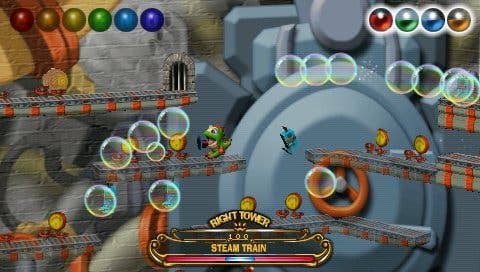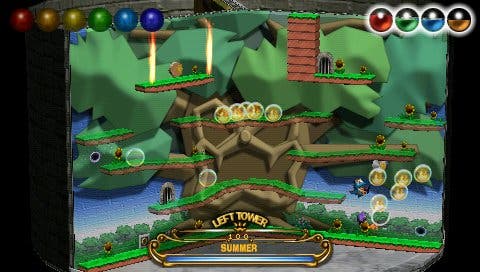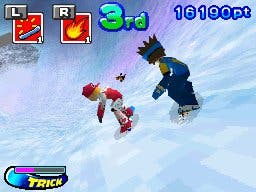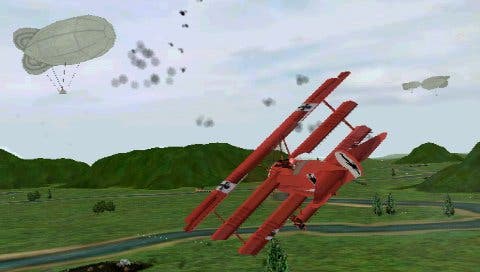Rising Stars
Bub Bob PSP, Rainbow Islands, Snowboard Kids and Pilot Academy.
Evolution or Revolution?

I felt the same about not being able to walk off with Bubble Bobble Evolution, although that was more because I wanted the PC midi-tower-style PSP devkit sat on the glass table than any immediate desire to continue playing the game.
Tony Byus is right - the developer's in an impossible position. Case in point - Bub and Bob are now little humans in cos-play dino suits using a trumpet to blow bubbles. Silly old me, I thought this was cute. One of the other journos I spoke to afterwards was enormously upset about this. The PSP, however shiny and powerful it is, isn't markedly different to the systems that you'll have played Bubble Bobble on in the past. So really, all that remains is for the devs to fundamentally alter the game and hope to hit upon something new and interesting without upsetting too many people.
The result in this case is a gently paced affair that involves blowing bubbles at enemies and switches, and moving objects between three coterminous 2d play areas to solve puzzles. The idea is that Bub and Bob are trapped in two adjacent towers, and they need to work their way up and down each to escape. Each storey represents a level for each character, and levels are split into three 2d areas that represent summer, autumn and winter respectively.

Viewed from above, the play area would appear as a circle divided into three slices of gamey pie. Each slice is viewed side-on, like a 2d level - albeit one that slants inward to a central point and then back out - with platforms, enemies, switches to operate, doors to go through, objects to move and so on. Many puzzles are based on reaching switches by using objects. For instance, you need to plant a seed in a flowerpot in the autumn area in order to grow a plant that will allow you to jump up and reach the exit at the top, but the seed's actually in winter. So, you need to find a way to winter and put the seed in a bubble, which then floats along a preordained air current toward a little hole in the level that pops it out in the next season. You then need to go there and ease its path to the next hole, and then to winter to help it along to the flowerpot. From there, you just need to get water to it. Variations on this theme involve changing the direction of air currents, rescuing items from behind fiery or icy barriers by finding ways to disable them and so on. We're also told to expect puzzles based on changing air pressure - producing tiny or huge bubbles as a result.
As you make progress in one tower, you can press L to switch the trumpet between Bub and Bob in their respective towers. Sometimes the puzzles will complement their other-tower counterparts, and there are also boss fights to consider. RSG tells us that there'll be 60 stages for each character, and some multiplayer modes.
It is a neat enough idea, and one that, while beholden to the conventions of Bubble Bobble (and sometimes struggling to work them in - some platforms allow you to drop down behind them by pressing down-and-A, but others don't, and it can be hard to tell them apart), is still quite distinct. The 3d-in-a-2d-game visuals feel more like they've been shoed in under the weight of PSP peer pressure than they need to be there, and the controls certainly needed work in the build we saw, but there's still time. Rather like oft-ignored PSP puzzler Frantix, the drawbacks are obvious, but there's a definite attraction.
The Kids really are alright

Snowboard Kids DS is already out in the USA. The reviews there have picked on it on a number of counts, and playing it certainly wasn't without concern. Tricks were initially quite hard to pull off, manoeuvrability wasn't up to SSX standards of analogue fluency, and trying to line up the "portal" back to the top of the slope at the end of each "lap" was a bit gruelling when you fouled it up.
On the other hand, if you can content yourself that not every DS game has to be an Advance Wars or a Mario Kart, it's simple, uncomplicated fun. The idea is to race to the bottom of the slope three times in a row ahead of your rivals, using Mario Kart-style power-ups to take them out and boost yourself, performing tricks to earn cash that can be spent unlocking new boards and tracks, and making liberal use of the stylus to perform high-scoring tricks.
You race down the slope, pressing B to jump (and holding it to tuck in and go faster with reduced steering control, much like SSX), using the d-pad to do flips and spins, and the shoulder buttons to activate one of the two power-ups you can hold at once. Power-ups are things like droppable ice blocks and mines, projectile snowballs and speed boosters. When you fill up an SBK bar with spins and flips off ramps, you can perform bigger tricks that demand the use of the touch-screen, which needs to be tapped in specific places in mid-air to perform them.

On the early levels it proved hard to get decently airborne to perform these tricks, but they banked a lot more points when they worked. There's also a separate tricks mode, and ten courses in total (two unlockable), and of course multiplayer, which we got to try out.
DS games often win out over PSP in multiplayer terms because the amount of data involved is much smaller. The art's not as complex, most obviously, and in general it's possible to chuck enough of it over the airwaves to play together with other people using just one copy of the game. Snowboard Kids supports this, but sadly only for one track - you'll each need a copy to play with the full suite of them. This will probably hurt the game come review, but with a second copy at our disposal we got to see it as intended, and it's entertaining. Playing against each other isn't always hugely competitive - you tend to be quite far apart unless you're both practised - but nailing each other with power-ups and easing over the finish line just in front of the pack is charming enough.
Good enough? We'll see. But simple, uncomplicated fun.
Pilot scheme

"Pilot Ni Narou!", roughly translated as "Let's Become A Pilot!", arguably has the most relevance to RSG's original manifesto as PRed back in February 2005. It's a Japanese game most people won't know about, it's good, and it's being done up in order to appeal to European gamers. In this case, by Kuju Sheffield. Kuju's Simeon Pashley had dragged a PSP devkit along on the train to give us a look at its progress.
I immediately liked it, and the reason was utterly random. PR svengali Simon Byron (svengali might be a harsh term, but he'll like it) was giving me a bit of background while Pashley took care of a phone call, and was failing to land a plane in one of the game's many "lessons". So I took over. Immediately it called Pilotwings to mind - using the shoulder buttons to control the rudder, and triangle and circle to throttle up and down, I guided a fairly slow plane through a series of rings in the sky and down to land, making hairline adjustments with a very feathery analogue flaps control, before throttling back and braking just in time to land perfectly. Well, it scored me 77/100 anyway.

The flaps demand a real deftness of touch. It's one of the things that's likely to be toned down for the launch, says Pashley, because you really can send the plane bucking and twisting into the ground if you're even remotely cack-handed. Or travelling on any manner of British transport, I'd imagine. But in spite of this, it's very engaging. There are all sorts of planes - everything from World War I biplanes up to F-15s - and lessons, missions and challenges that run the whole gamut. Lessons unlock missions unlock challenges, and in general you'll always have more than one way to continue. You'll also be able to partake in (multi-UMD) multiplayer in several modes - including a tag-style game where the object is to avoid being hit for as long as possible. Dogfighting, our press literature says, will be available whether the players each own a copy of Pilot Academy or not - and Pashley tells us that you'll be able to pit F-15s against biplanes and so on if you really want to.
On the whole I thought I would. Civilian flight simulators are often dismissed out of hand by gamers of all walks for being incredibly tedious; Pilot Academy is unlikely to attract the same stigma when people realise that it's somewhere in-between. Whether it's navigating rings on complex courses in a 747 or attacking Japanese Zeroes patrolling around destroyers, it's not quite as accessible as something like Starfighter, but the subtlety it seems to demand is clearly and gently outlined, and it could appeal to the arcade mentality of players hunting for medals and higher points-scores. People will be able to succeed without having to read flight manuals, but those who recognise the need to circle around a hillside to reach AA guns on the other side rather than going up and over and exposing the fuselage will be better rewarded.
Tidings rise
Those worried about draw distances on the PSP should throttle back their anxiety too. Pilot Academy's understandably not the most graphically impressive game on the PSP as a result, but they're fine. Clear skies ahead? Like the rest of the games we're shown, it's got potential; 2005 may not have been kind to Rising Star, but walking back to the tube station a couple of hours later, the sun now set, I could see more of the sky through the trees.
And if you'd rather have that in plain English: Rising Star doesn't have a Mario Kart or a Resident Evil 4, but I can see myself playing some of these games, and that's a good start.
